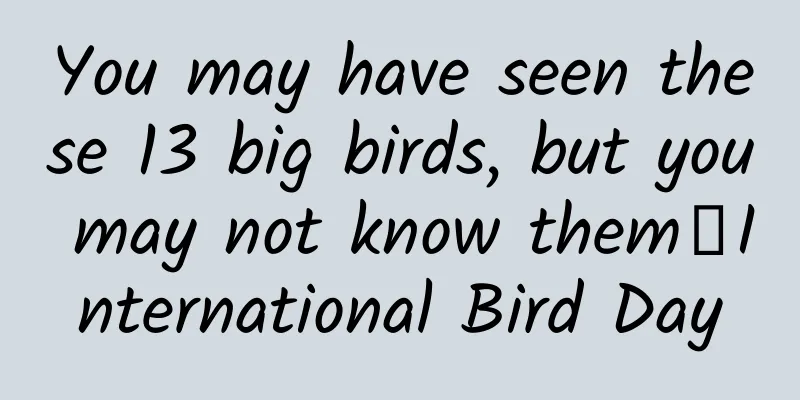You may have seen these 13 big birds, but you may not know them丨International Bird Day

|
"A few early orioles compete for warm trees, and spring swallows peck at spring mud." Seeing such a lively scene, it is inevitable that your heart will jump with joy. Even though we who live in cities have gradually moved away from nature, there are many birds that have adapted to life in the city and accompany us every day. The World Convention for the Conservation of Beneficial Birds stipulates that April 1st of each year is International Bird Day . Let's take this opportunity today to talk about the common birds in the city. Since everyone is familiar with small birds such as sparrows and swallows, today we will focus on the larger birds. The big guys of Corvidae are not to be trifled with Let's first talk about the "big guys" of the Corvidae family that are common in the city, including crows, magpies, and gray magpies. These birds are not only large in size, but also very fierce. They dare to fight against birds of prey in the sky, beat cats and dogs on the ground, and even beat people if they provoke them. They are all Corvidae birds, so people give them a collective nickname "Corvidae Big Guys". Let's talk about crows first. They are the best birds that adapt to the city. They are not only not picky about food, but also have high IQ and are very smart. They will make full use of various human facilities to seek benefits for their own lives. For example, some crows will throw nuts such as walnuts on the road so that the cars coming and going can help crush the hard shells. With such adaptability, crows have become one of the most common birds in metropolises around the world. There are also a large number of crows in Beijing. There are two common crows in Beijing, one is the small-billed crow and the other is the large-billed crow. Because they often move together, it is a bit difficult to distinguish them if you don't know the key points. In fact, the main difference between the two crows is their beaks. One has a large beak and a little arched on the top, while the small-billed crow has a small beak and a relatively flat top. Big-billed crow. Note its large beak and the transition between the beak and the head. Photo by the author Small-billed crow. Note that it has a smaller beak and the beak is more smoothly connected to the head. Photo by the author The magpie and the crow belong to the same family of corvids. Just because of their colors and calls, the former has become a symbol of joy while the latter has become a symbol of bad luck. It is really fate that plays tricks on birds. The magpie's black feathers seem to be nothing special, but under the sun, the black feathers glow with a variety of colors, which can be said to be "colorful black". Photographed by the author of Magpie The magpie's nest is very delicate, with thick branches forming the outer shell and frame, and thinner branches filling the interior. Finally, soft grass and feathers are used as "bedding". The whole process takes the two birds more than a month to prepare - the greening ginkgo trees suffer, as their branches are broken off and used as building materials. The most ferocious one is probably the gray magpie (I have really been beaten by them). Although there is a "gray" in the name, the gray magpie is not a gray version of the magpie. They are mainly gray-blue in color, and are smaller in size than magpies. They may not be as good at singles as magpies, but magpies don't like to gather in groups, while gray magpies are gregarious. Gray magpies in an area will forage in groups and protect their underage cubs in groups, so you can see them flying in groups in the sky. During my four years in college, I watched the gray magpies expand little by little on campus, slowly squeezing the magpies out of the campus territory. Gray magpie photographed by the author In the north, magpies and gray magpies are more common, but in the south, there are fewer magpies and gray magpies, but there is one more beautiful species in the Corvidae family - the red-billed blue magpie. In fact, there are not many of them in southern cities, because they prefer to stay in the suburbs or farther away in the forest. It has bright blue-purple feathers, which complement the black and white feathers. The red beak is simply the finishing touch. At the same time, the tail alone accounts for more than half of the half-meter body length, and it is very elegant when flying. Red-billed blue magpie photographed by the author But the only drawback is that such a beautiful bird still makes a sound like that of a corvid when it opens its mouth, similar to the "chirp" of a magpie, but sharper, which is somewhat unworthy of its beauty. Aquatic birds have many emojis The water systems in many cities are now well managed, and aquatic birds are gradually becoming more abundant. Let's start with the most common ducks. Mallards and spot-billed ducks are the most common birds in urban waters. The male mallard has a brightly colored and iconic metallic head. The male and female spot-billed ducks look similar, and the only distinguishing feature is the yellow spot on the tip of their bills. Mallard duck photographed by the author In some cities, mandarin ducks have become common birds. Like ducks, mandarin ducks belong to the Anatidae family. They were originally migratory birds, but now many mandarin ducks have changed their habits and settled in cities. This is because they are often fed by tourists, and there is indeed enough food in the city. As a result, they have become a landscape in city parks. Of course, we still want to remind everyone not to feed these wild birds, otherwise it may affect their health. Mandarin ducks and ducks fighting for food. Photographed by the author The waterfowl swimming in the water may be a duck, but it may also be a "chicken". There is a kind of waterfowl that is all black except for a little red on its beak. It is called "Black-bellied Swamphen". It is neither a duck nor related to the chicken we eat most often. It is also a frequent visitor in urban waters, but is often called a duck. Unlike ducks, Black-bellied Swamphens do not have webbed feet, so it is a bit difficult for them to swim in the water. Therefore, compared to swimming, they prefer to stroll on the water's edge. Black moorhen photographed by the author There is another type of "water duck" that is even smaller - the little grebe. Ducks usually do not dive deep to eat. When they dive into the water to eat, their tails will stick out of the water. Ducks also move gracefully and slowly. The little grebe's movements are a bit "startling". When they fish, they will completely dive underwater. If someone approaches, they will also dive quickly and disappear. Sometimes they will suddenly take off and perform a "lightweight water floating" to escape danger. Photographed by Little Grebe Editor When talking about water birds, we must mention the various herons. With the exception of the cattle egret, which eats insects, all herons feed on fish. They have three strengths: a long beak, a long neck, and long legs, which fully adapt to shallow water fishing (so most of them don't swim much). Perhaps we should also add "long patience", because herons can wait quietly for hours in one place to catch fish. Next, I will introduce two common herons in life and on the Internet. The egrets in “a line of egrets flying into the blue sky” are very common, and the “repeatedly trying” emoticon on the Internet comes from egrets. The picture comes from the Internet There are more than just white egrets, but they have one characteristic: a pair of striking yellow socks. Egrets go out to fish every morning and return to the trees to rest in the evening. Perhaps it was evening when a line of egrets flew up to the sky. Note the yellow on the egret's claws Photo by the author The funniest heron is the night heron. Because they are often photographed and have a variety of feathers and movements, they are easily mistaken for other birds. They are known as "masters of mimicry" and have contributed a large number of emoticons to the majority of netizens. The picture comes from the Internet The night heron has the color of a penguin, and with its neck tucked in, it really has a bit of penguin temperament. A night heron sneaked into the penguin house of a zoo and was found only after a while. A night heron once sneaked into the penguin house at Ueno Zoo in Tokyo and cheated people to eat and drink. From Wikipedia Immature night herons are not as brightly colored. Their brown feathers allow them to blend in with the tree bark when they sleep during the day, making them safer. Night heron comparison photo taken by the author Unlike most herons, night herons only come out to hunt at night, so during the day we can see groups of night herons sleeping in groups by the water, and it is difficult to see them flying and hunting. Birds of prey in the city are not to be touched If you look up and see a large bird circling in the sky, you can almost be sure it is a raptor. Raptors are not uncommon in cities, and many of them raise their babies in huge magpie nests in city parks. Common birds of prey in cities include the common buzzard and the black kite. We can often see them hovering, and we can tell them apart by looking at the color of their wings. The black kite has dark feathers on its wings, while the common buzzard is lighter white. Common buzzard from wiki Hovering black kite Photographed by the author These two common large birds of prey generally do not move too low in cities. In addition to the impact of human activities, the endless harassment from magpies and gray magpies may also be a major reason. There are also some small birds of prey in the city, and the kestrel is their representative. There are a large number of spotted doves, and they can build nests and lay eggs anywhere, but this is really no concealment for the kestrel. The kestrel will catch the young that the doves have worked hard to raise (they only lay two eggs at a time) and carry them away with one claw once they are discovered. With spotted doves as food, the kestrel has basically no worries about life in the city. With food, it has to consider having babies. The kestrel will also make full use of the terrain - some extended areas outside the building, and even on the air conditioner outdoor unit, which feels a bit like a "cliff". If you are lucky enough, you can also observe owls in the city. There are actually quite a few owls in the city, but it is quite difficult to see them during the day. They come out at night, so they hide in the dense branches during the day to hide themselves. In addition, the color of their feathers is really inconspicuous and blends in with the bark. The eagle owl in Beijing city is hard to spot without careful observation. Photo by the author Let me add one more thing here. If you pick up a bird with a beak and claws like hooks and eyes facing forward, it is most likely a bird of prey. Birds of prey are nationally protected animals. You should quickly contact the local forestry department for help. What can we do to love and protect birds? There are many birds living in cities, and some migratory birds will stay temporarily. As a result, any city may have one or two hundred species of birds or even more. What can be done to protect these birds? First of all, we need to understand where some of the threats to the lives of birds in cities come from. The window glass of buildings in the city is a big danger. There are countless cases of birds hitting the glass and dying. So we can put some raptor silhouette stickers on our windows. Birds are very alert and will hide when they see raptors. This can help to avoid bird strikes. Stray cats (and their offspring) abandoned by their owners in cities are also a major natural enemy of birds. Cats are agile and sometimes kill birds just to relax rather than to be hungry. Therefore, at least friends who have cats should not abandon them. In addition, people have also begun to feed wild birds. For example, red-billed gulls are used as tourist attractions in various places. People feed them human food, which is often high in oil and salt, and can cause considerable harm to birds. If you love birds, don't feed them. In addition, there are some specific protection work. For example, in the spring bird breeding season, strong winds can easily blow baby birds out of the nest. If you can send them back to the nest, that's the best. If you can't find a nest, you can put the baby birds in a high place so that the bird parents can rescue them themselves. If you encounter an injured bird (especially one that has hit glass), if it is still alive, you can contact the local rescue station. For those who use slingshots to shoot birds, it is necessary to persuade them or even report them. There is still a lot we can do to love and protect birds, but I think the most important thing is to make more people interested in birds, pay more attention to them, know that in our city, there is still a group of elves living with us, enjoy the fun of observing them, and then develop the desire to protect them. Planning and production Author: Ye Zhengrong, popular science author Review丨Huang Chengming, Professor of Hainan University Planning丨Ding Zong Editor: Ding Zong Proofread by Xu Lai and Lin Lin The cover image and the images in this article are from the copyright library Reprinting may lead to copyright disputes |
<<: Aspartame is harmful to cardiovascular system, so we can no longer drink sugar-free beverages?
Recommend
What? Asteroids also have osteoporosis?
As people age, if they do not pay attention to ca...
When will the 20th National Congress be held in 2022? What is the content of the meeting and its significance?
The full name of the 20th National Congress is th...
The "love flower" described by Jin Yong that "scratched the beauty's face" and caused Yang Guo great suffering...what are these flowers?
The camellia that "scratches the face of a b...
Event Operation Planning丨How to plan a fission event?
With the fading of traffic dividends in recent ye...
How to get more customers smartly?
If we divide the company's customer base base...
Scientific answers: What is the time dilation effect of relativity, and can it make people immortal?
Yesterday, I published an article introducing the...
Mobidev: Top 3 Fintech Trends in 2022
As one of the most disruptive industries, FinTech...
WeChat official accounts have added a new "My Store" function to support small stores selling goods
WeChat official accounts have launched a new feat...
How much does it cost to attract investment for Jinchang’s flash sale mini program?
Jinchang Seckill Mini Program investment promotio...
Without tens of millions of users, how can the value of To B operations be reflected?
Compared with To C operations , To B operations a...
【Smart Farmer】Illustrated Book|Have you eaten crabs today?
Crabs are delicious and fun aquatic creatures. Th...
How did people grow vegetables on the Mir Space Station more than 30 years ago?
The designer of the world's first fully funct...
No KOC, no community
KOC , or key opinion consumer, generally refers t...
A review of the 2015 BAT campus recruitments: some increases and some decreases
It is the beginning of another school year, and i...









